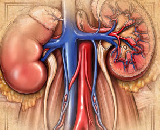Renal Ischemia-Reperfusion Injury (RIRI)
Renal Ischemia

Ischaemia-reperfusion injury is a complex interrelated sequence of events that classically involves the vascular endothelium and activated leucocytes. During the ischaemic phase the endothelium is primed both to produce free radicals and to secrete chemoattractants. The resultant neutrophil sequestration serves to amplify the injury.
Renal ischaemia-reperfusion injury is complex for, while ischaemia primes the tissue for reperfusion damage, it also causes early and irreversible tubular injury. Furthermore, it appears that relatively less importance should be attached to the involvement of neutrophils than at other sites, and relatively more to a local postischaemic imbalance in the levels of nitric oxide and endothelin. Models for renal ischaemia-reperfusion injury are widely used in rats, mice for research of acute renal failurerenal transplantation and changes of cytokins.
Organism species: Mus musculus (Mouse)
- Disease model DSI529Mu01 Mouse Model for Renal Ischemia-Reperfusion Injury (RIRI) In Stock
- Tissue TSI529Mu15 Mouse Tissue of Renal Ischemia-Reperfusion Injury (RIRI) In Stock
- Tissue TSI529Mu09 Mouse Tissue of Renal Ischemia-Reperfusion Injury (RIRI) In Stock
- Tissue TSI529Mu21 Mouse Tissue of Renal Ischemia-Reperfusion Injury (RIRI) In Stock
- Customized Service n/a Serums of Renal Ischemia-Reperfusion Injury (RIRI) (If Necessary) Serums Customized Service Offer
Organism species: Rattus norvegicus (Rat)
- Disease model DSI529Ra01 Rat Model for Renal Ischemia-Reperfusion Injury (RIRI) In Stock
- Customized Service n/a Tissue of Renal Ischemia-Reperfusion Injury (RIRI) (If Necessary) Tissue Customized Service Offer
- Customized Service n/a Serums of Renal Ischemia-Reperfusion Injury (RIRI) (If Necessary) Serums Customized Service Offer
Organism species: Cavia (Guinea pig )
- Disease model DSI529Gu01 Cavia Model for Renal Ischemia-Reperfusion Injury (RIRI) In Stock
- Customized Service n/a Tissue of Renal Ischemia-Reperfusion Injury (RIRI) (If Necessary) Tissue Customized Service Offer
- Customized Service n/a Serums of Renal Ischemia-Reperfusion Injury (RIRI) (If Necessary) Serums Customized Service Offer
Organism species: Oryctolagus cuniculus (Rabbit)
- Disease model DSI529Rb01 Rabbit Model for Renal Ischemia-Reperfusion Injury (RIRI) In Stock
- Customized Service n/a Tissue of Renal Ischemia-Reperfusion Injury (RIRI) (If Necessary) Tissue Customized Service Offer
- Customized Service n/a Serums of Renal Ischemia-Reperfusion Injury (RIRI) (If Necessary) Serums Customized Service Offer
Organism species: Canis familiaris; Canine (Dog)
- Disease model DSI529Ca01 Canine Model for Renal Ischemia-Reperfusion Injury (RIRI) In Stock
- Customized Service n/a Tissue of Renal Ischemia-Reperfusion Injury (RIRI) (If Necessary) Tissue Customized Service Offer
- Customized Service n/a Serums of Renal Ischemia-Reperfusion Injury (RIRI) (If Necessary) Serums Customized Service Offer


